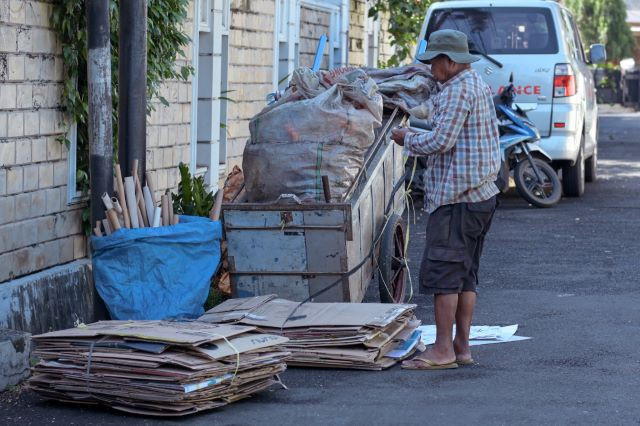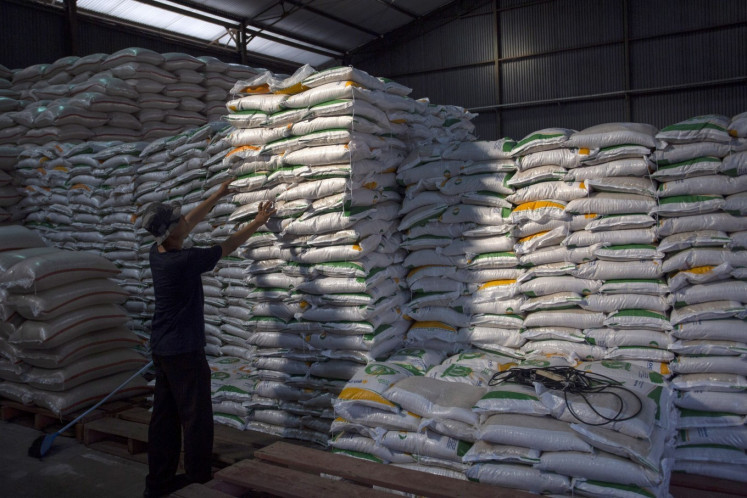Popular Reads
Top Results
Can't find what you're looking for?
View all search resultsPopular Reads
Top Results
Can't find what you're looking for?
View all search resultsAddressing economic inequality
One of the causes of widening income inequality is the structure of personal income tax (PIT), which until 2021 favored the upper middle income and rich taxpayers.
Change text size
Gift Premium Articles
to Anyone
 Street economy: A scavenger ties up used cardboard boxes he salvaged to sell for recycling, on Feb. 22, 2022, in Jakarta. Extreme poverty in Jakarta stood at 0.89 percent of the population as of March 2022, according to Statistics Indonesia (BPS), with the city government aiming to bring it to zero next year. (AFP/Bay Ismoyo)
Street economy: A scavenger ties up used cardboard boxes he salvaged to sell for recycling, on Feb. 22, 2022, in Jakarta. Extreme poverty in Jakarta stood at 0.89 percent of the population as of March 2022, according to Statistics Indonesia (BPS), with the city government aiming to bring it to zero next year. (AFP/Bay Ismoyo)
E
conomic inequality was one of the issues raised over the last few weeks during the presidential election campaigns, but unfortunately, none of the three candidates put forward a comprehensive strategy on how to address such an important and multi-faceted problem.
Economic inequality, notably in income and wealth ownership, should have been discussed vigorously because of its connection to economic instability and political unrest. Various surveys have found a correlation between economic inequality and slow economic growth. An excessive concentration of wealth is considered a risk for democracy as those at the top have too much bargaining power to influence the course of public policies.
Even though extreme poverty in the country has declined, income disparity last year was the worst in the last five years. According to the Gini coefficient, income inequality rose from 0.380 in 2019 to 0.388 in March 2023, remaining among the highest in Asia. The Gini coefficient measures the extent to which the distribution of income or consumption among individuals or households within an economy deviates from a perfectly equal distribution. A Gini coefficient of 0 represents complete equality, while an index of 1 implies complete inequality.
In wealth ownership, the disparity is even worse. The Paris-based Global Inequality Report of 2022 said that Indonesia ranked sixth in wealth inequality worldwide. The four richest men in Indonesia have more wealth than the combined total of the poorest 100 million people.
According to the Deposit Insurance Corporation, as of last year, there were a total of 554 million bank accounts with a total of Rp 8.24 quadrillion (US$527.36 billion) in the country. About 98.8 percent or 547 million of these accounts each held less than Rp 100 million, but these accounts together held only 12.3 percent of total deposits in the banking industry. Meanwhile, 135,000 accounts, each with more than Rp 5 billion, controlled Rp 4.6 quadrillion or 53 percent of total bank deposits.
This concentration of wealth in the hands of a few means that only a small number of people earn income from financial and property assets. This has driven economic inequality even higher.
Another indicator of economic inequality is land ownership or distribution. Tempo daily newspaper quoted data from the National Land Agency showing that the Gini coefficient in land ownership in Indonesia in 2022 was 0.58. The Gini coefficient is a measure of inequality on a scale of 0 to 1. A zero coefficient means that all agricultural holdings have the same amount of farmland.
One of the causes of widening income inequality is the structure of personal income tax (PIT), which until 2021 favored the upper middle income and rich taxpayers as the highest tax rate was only 30 percent and was applied to everyone with an annual income of more than Rp 500 million even though many corporate executives, including those at state companies, may earn between Rp 2-5 billion. It was not until 2022 that the government restructured the rates to create five categories with a 35-percent rate imposed on those earning more than Rp 5 billion.
It is no wonder, therefore, that according to the directorate general of taxes, PIT receipts contribute only about 10 percent of total tax receipts. Even more discouraging is that 90 percent of PIT receipts are derived from labor wages and only around 10 percent from non-employees who comprise high net-worth individuals (HNWIs) such as businesspeople and high-skilled professionals.
But the impact of the tax rate restructuring will depend on the implementation of the core tax system, which will set up a modern, integrated and digital platform to improve efficiency, transparency and overall tax administration.
The tax reform should still be supported by coordinated efforts across multiple fronts that include policies to promote inclusive economic growth and improve access to education, healthcare, decent-paying jobs, equal employment, land redistribution, social safety nets and financial services.










